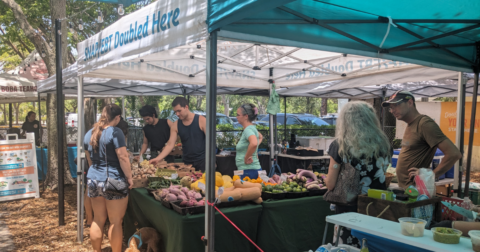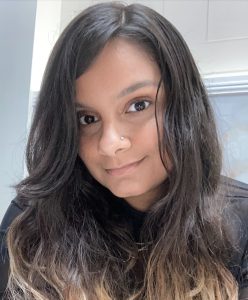News
Methane Emissions from the World’s Biggest Meat Companies Are Bigger Than From Major Oil and Gas Companies
Climate•5 min read
Solutions
This local food strategy also happens to be a boon for climate action.


Words by Grace Hussain
I wipe the sweat that’s beaded across my forehead. It’s a balmy Saturday in South Florida, and I’m standing outside in the heat, surrounded by vegetables. I’m talking to Art Friedrich, founder of Urban Oasis Project, a nonprofit working to strengthen Miami’s local food movement. “Good food should be considered a right for everyone,” Friedrich tells Sentient. For Friedrich, good food means more produce and less meat. The project aims to help communities get healthier while lowering their climate impact.
Founded in 2008, Urban Oasis Project runs an array of programs aimed at getting more fruits and vegetables to their neighbors. We’re at one of two farmers markets the project runs in South Florida. At this one, a few dozen vendors hawk their goods, surrounded by the historic pink and yellow buildings, towering banyan trees and colorful peacock residents of Vizcaya Museum and Gardens’ village.
The location of the market, historic Vizcaya Mansion, is no stranger to the pressures of climate change. The nonprofit has had to hire engineers in recent years to stave off the effects of sea level rise and preserve the historic estate and gardens.
The global food system accounts for around a third of all greenhouse gas emissions, with beef production largely driving that number. Curbing climate emissions happens to be a benefit of Urban Oasis Project’s work to get people eating healthier.
“We want people to eat more fruits and vegetables,” says Friedrich. “As long as they’re eating fruits and vegetables, it is going to be incredibly beneficial to their health.”
Florida’s lack of income tax and bounty of pristine beaches have attracted droves of new residents, including a recent influx of millionaires. But as new Miamians flock to the city, many longtime residents are struggling to afford healthy food.
Miami’s food costs have increased over the past several years, and along with it the cost of other necessities, including housing. Feeding South Florida, another nonprofit working on food insecurity in the area, has seen a surge in the number of people looking for their help, Paco Vélez, Chief Executive Officer of the organization, told Sentient via email.
Miami’s intensifying wealth gap has been a challenge for Urban Oasis Project as well, mostly in attracting folks to a farmers market situated on the grounds of a historic mansion. “For the first year or two, it was pretty hard to get some customers here to Vizcaya, because of the history of Vizcaya, and the reputation that it’s some rich dude’s estate,” says Friedrich.
It’s a challenge that Urban Oasis Project and Vizcaya as an institution have worked hard in collaboration to overcome. Two of the factors that help draw people to the Vizcaya market are its convenience to public transit — it’s an 11 minute walk from the nearest Miami metrorail station — and Urban Oasis Project’s SNAP doubling program.
The program doubles the value of SNAP recipients’ benefits when they buy produce, and is part of Feeding Florida’s Fresh Access Bucks initiative that supports similar initiatives at over 80 locations across the state.
At the moment, President Trump’s “Big, Beautiful Bill” — and almost $300 billion in cuts to SNAP — is a significant and looming threat. Friedrich is concerned for his community and their ability to access fresh, healthy food.
“It’s going to be really devastating if these proposed cuts to overall SNAP benefits happen. People are going to go hungry, and people are not going to get their nutritional needs met. Kids are going to suffer,” he says.
Friedrich feels confident the nonprofit will at least survive. “I never wanted to be grant-dependent for exactly these reasons, because I lived through many administrations that are hostile to working people and formerly working people,” he says.
But there are consequences. Urban Oasis Project had been selected to receive funding via an Inflation Reduction Act program in 2023 — but the promised funds were among those cut by the Trump Administration. This meant the organization wasn’t reimbursed for expenses it had already incurred, despite the contract requiring the government do so, says Friedrich.
And there are bigger effects to grapple with. “It’ll certainly be a loss of income for us, which means a loss of income to all the farms that we source from,” he says. “We only buy what we can sell, so if we can’t sell as much, we can’t buy as much.” And future projects are on hold too, including a plan to buy land for starting a farm of their own.
As I’m talking to Friedrich, customers crowd around the fruits and vegetables overflowing from the Urban Oasis Projects’ tables. We’re interrupted on several occasions by regulars who want to say hello, and on one occasion, by someone wanting to sell the mangos from their backyard tree — an offer Friedrich gladly accepts.
These deep community ties are the foundation of Urban Oasis Project. The charge for vendors to sell here is $50 (many other markets charge hundreds), but instead of just letting in anyone who can pay, Friedrich is selective. The vendors who are the best fit are those that view the market as a way to be “mutually supportive,” willing to buy from each other and build relationships.
The day that I’m there, Urban Oasis Project shares some mushrooms with a vendor selling Korean fried chicken. They want to test out frying the mushrooms to see whether it can work as a meat-free addition to the menu.
It’s a culture the vendors appreciate. “I believe in this market, because it’s the one market that showed us that we can do this,” Wanderson Oliviera, cofounder of Dolce Mio, tells Sentient. He sells Italian treats out of his booth. The Vizcaya market was his first as a vendor, and part of what gave him the confidence to leave his daytime job and focus full-time on the business. Though he vends at numerous markets these days, he plans on always selling here.
Friedrich sources from both organic and conventional farms for produce, aiming to “have every different vegetable represented.” Many shoppers don’t know what the organic label means, Friedrich finds, so they label everything and stay open to having a conversation with curious shoppers.
And to encourage customers to lower their climate impact and improve their health, Friedrich likes to say, “just eat half as much meat.” It doesn’t have to be the whole meal, says Friedrich, but more like adding a flavor or “a condiment.”